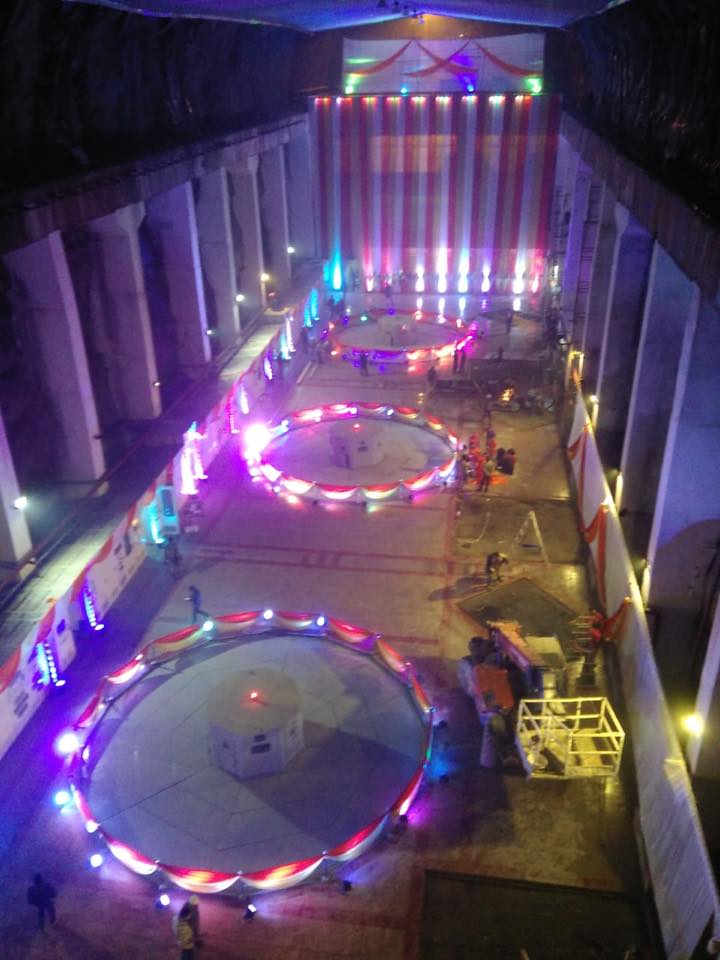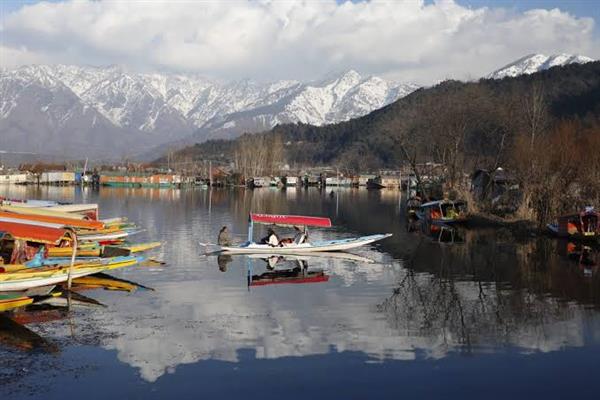- After failing many deadlines, project set to be inaugurated by PM
- Pak concerned over inaguration of Kishenganga project
The 330 Megawatt Kishen Ganga Hydro Electric Power Project, a project of great strategic value,would be inaugurated on Saturday by Prime Minister Narender Modi from Sher-e-Kashmir International Conference Centre (SKICC).
After failing many deadlines stemming from adverse climatic conditions, public uprisings and tug-of-war with affected people, the project is set to be inaugurated on Saturday.
The construction of the project was completed amid a legal battle between India and Pakistan.
Pakistan in 2010 initiated proceedings on sharing Kishen Ganga’s waters but lost the case in 2013 when the International Court of Arbitration “recognized” India’s rights over the river.
The executing agencies National Hydroelectric Power Corporation (NHPC) in collaboration with Hindustan Construction Company (HCC) assisted by the district Bandipora administration have completed the preparations for the inauguration of the project.
With 23.68 meters high dam and maximum gross head of 665 m, the project would generate 1350 Million Units of energy, with an installed capacity of 330 MW(3×110 MW).
The project has an underground three units of Pelton Wheel Turbines, and each unit has 110 MW capacity.
Of the total generated electricity 13 percent would be supplied free to the Jammu Kahsmirwhile 1 percent of yearly revenue generated from the project would be utilized for the development of the affected villages.
Spread over 379 hectares across two townships-Gurez and Bandipora, the 800 million dollar Hydro Eclectic Power Project built along Kishen Gaga River (Neelam) is being inaugurated albeit incomplete excavation of downstream channels Bonar and Madhumati.
Even the compensation under Relief and Rehabilitation Plan was approved by during a recent meeting held at Chief Secretary Bharat BushanVyas’s Office at Srinagar.
Corroborating the complainants of the local’s few field officials representing Public Health Engineering (PHE) department told Kashmir Post that workers faced a lot of difficulties to dispose of the massive rocks and material during the excavation process of the streams.
“Earlier, the project was set to be inaugurated in April but the hectic excavation of material from downstream Bonar and MadhumatiNallah delayed the deadline,” officials told Kashmir Post.
The project was in news in March when residents in ChekMantrigam and Kraplora complained of leakage from the main tunnel.
However, experts in executing agency said the minor glitch was caused due to improper grouting that now stands rectified.
Missing Deadlines
The project missed four deadlines since 2017 including two deadlines during the year 2018, two in the year 2017.
The work on the project began in the year 2007 but was immediately stalled following the brief agitation launched by affected villagers to get their demands fulfilled.
The work was restarted in the year 2009 and was expected to be completed by 2016, but the bad weather conditions coupled with consecutive public protests delayed the work.
The work was stalled in the year 2010,2011 and 2016 for months together due to public uprisings as the machinery and workers were not able to reach the operational sites.
Besides, the harsh weather in Gurez hampered work at the dam site during the early five years of the construction work.
Earlier, the project was supposed to be commissioned in September 2017.
Another deadline was fixed as December 2017 end.
Later, former Union Power Minister PiyushGoyel announced January 2018 as commissioning date and it was recently announced that the project would be commissioned in the month of March.
After 12 years of construction, the project is all set to be inaugurated on Saturday though the executing agencies have charged all the three turbines and the corresponding 69 transmission towers.
The final check of the 23-kilometer tunnel was carried in the month of March.
This is one of the longest Head Race Tunnels in India with maximum overburden (height of a mountain above tunnel) of 1470 m.
In January 2018, HCC had successful trail test of three turbines.
The three turbines of 110 Megawatt were commissioned in the month of March.
“We were ready in the month of March when we had the final check of the main tunnel,” an engineer in HCC said.
DAM Filling
The process of filing 23.86-meter high dam reservoir with over 6 million cubic meters of water was started in June 2017.
Over 400 cusecs of water at the rate of 45 cubic water per second would be drained through a 23 kilometre tunnel to feed three turbines at Mantrigam Bandipora.
A maximum gross head of 665 m is proposed to be utilized to generate 1350 Million Units of energy, in a 90 percent dependable year with an installed capacity of 330 MW.
The different sites including submergence area of Project cover an estimated area over 379.07 hectares of forest and non-forest land including 125 hectares forest land, and 254.07 hectares non-forest land.
KHEP is being executed by the public sector NHPCat a cost of Rs57.8 billion by the HCC and US-based Halcrow Group.
The project is part of a run-of-the-river hydroelectric scheme designed to divert water from the Kishan Ganga River to a power plant in the Jhelum river basin.
J&K, Himachal Pradesh, Punjab, Haryana, Uttar Pradesh, Uttaranchal, Rajasthan, Union Territory of Chandigarh and Delhi are the main beneficiary of Indian states of the project.
Project Affected Families
Despite the fact that the project is considered a threat to both Bandipora and Gurez areas of the district, over 860 families are being affected by the project.
The affected families are either losing their dealings or their ancestral land.
Among the 860 families include fully affected 150 (from Bandipora and 143 from Gurez) families while 660 including 110 from Bandipora and 550 from Gurez are partially affected.
A total of 693 families are affected by dam construction while 167 by powerhouse construction.
Accidental Deaths
During the 11 years of construction, over two dozen accidental deaths were reported from different operational sites.
According to the officials in executing agencies, over 23 people, mostly drivers and workers lost their lives either in bad weather conditions or during the transportation of heavy machinery.
The officials said most of the accidental deaths occurred near the dam site during cold weather.
“Most of the deceased workers were earthier residents of other states who died due to harsh weather conditions or the workers related with transporting heavy machinery,” they said.
Workers were exposed to minus 15 degree Celsius temperature at the Gurez sites and most of the outsider workers were not exposed to such a harsh winter that caused many deaths due to weather conditions.
Over nine locals were reported dead during the last few years but either in road accidents or during tunnel operations.
Compensation
The government has disbursed over Rs4 billion to compensate the loss of land acquired for the project construction which includes Rs1.89 billion for PAF of Gurez and Rs1.25 billion for PAF of Bandipora.
Around Rs 2 billion (1,89,57,43,987) have been disbursed for 4200 kanal of land acquired for the project construction in Gurez while 653 households in two villages -Khophri and Badwan-are submerging under the dam, and of the all 653 households, 515 are partially submerging while 143 are submerging fully and need rehabilitation under the norms.
Over Rs1.43 crore were disbursed for the trees coming under the dam construction.
Government records show that 38 lakh each have been released and disbursed to the 143 affected families, however, among 143 families only 22 opted for plots acquired by the government to rehabilitate them in Wanpora village of Gurez, while the rest received the amount for their houses and other property.
Similarly, the government has also distributed compensation worth Rs 1 billion, 880 millionfor 752 kanal of land acquired for the powerhouse in Mantrigam area of Bandipora, while 160 families have lost land to the project in Bandipora side.
Chronology
2007: NHPC beginsdevelopment of Kishan Ganga Hydro Electric Power Project
2009: HCC in a joint venture with Halcrow was awarded the contract to construct the project on EPC basis.
2010: Pakistan appealed to the Hague’s Permanent Court of Arbitration(CoA), complaining that the Kishan Ganga Hydroelectric Plant violates the Indus River Treaty by increasing the catchment of the Jhelum River and depriving Pakistan of its water rights.
2011: In June 2011, the CoA visited both Kishan Ganga and Neelum – Jhelum Projects. In August 2011, the court ordered India to submit more technical data on the project. After Pakistan’s application was first rejected, the court asked India in late September to stop constructing any permanent works that would inhibit restoration of the river. While India cannot construct the dam, they can continue on the tunnel and power plant in hopes that the court will allow the project.
2013: In February 2013, Hague ruled that India could divert a minimum of water for their project. In this partial award, the court upheld India’s main contention that it has the right to divert waters of western rivers, in a non-consumptive manner, for optimal generation of power. On 20th December 2013, the International Court of Arbitration gave its final award, wherein it allowed India to go ahead with the construction of the Kishan Ganga dam in Jammu Kashmir over which Pakistan had raised objections.
Kishan Ganga River at all times to maintain the environment downstream.
2018: Pakistan informed the World Bank about India’s completion of the Kishan Ganga hydropower project urging it to “recognise its responsibility” under the Indus Waters Treaty.
Meanwhile, Pakistan on Friday voiced concern about the inauguration of the Kishenganga hydroelectric project in Jammu and Kashmir by Indian Prime Minister Narendra Modi on Saturday.
“Pakistan believes that the inauguration of the project without the resolution of the dispute is tantamount to violation of the Indus Waters Treat,” a Foreign Office statement said.
During his two-day visit to Jammu and Kashmir on Saturday and Sunday, Modi will inaugurate the 330 MW power project in Bandipora district on Saturday.
The Pakistani statement said that despite several rounds of bilateral negotiations as well as mediations under the auspices of the World Bank, India continued with the construction of the project.
“This intransigence on part of India clearly threatens the sanctity of the treaty.”
Pakistan has raised objections over the design of the hydel project in Jammu and Kashmir, saying it is not in line with the criteria laid down under the Indus Water Treaty between the two countries.
India says the project design was “well within parameters” of the treaty.






